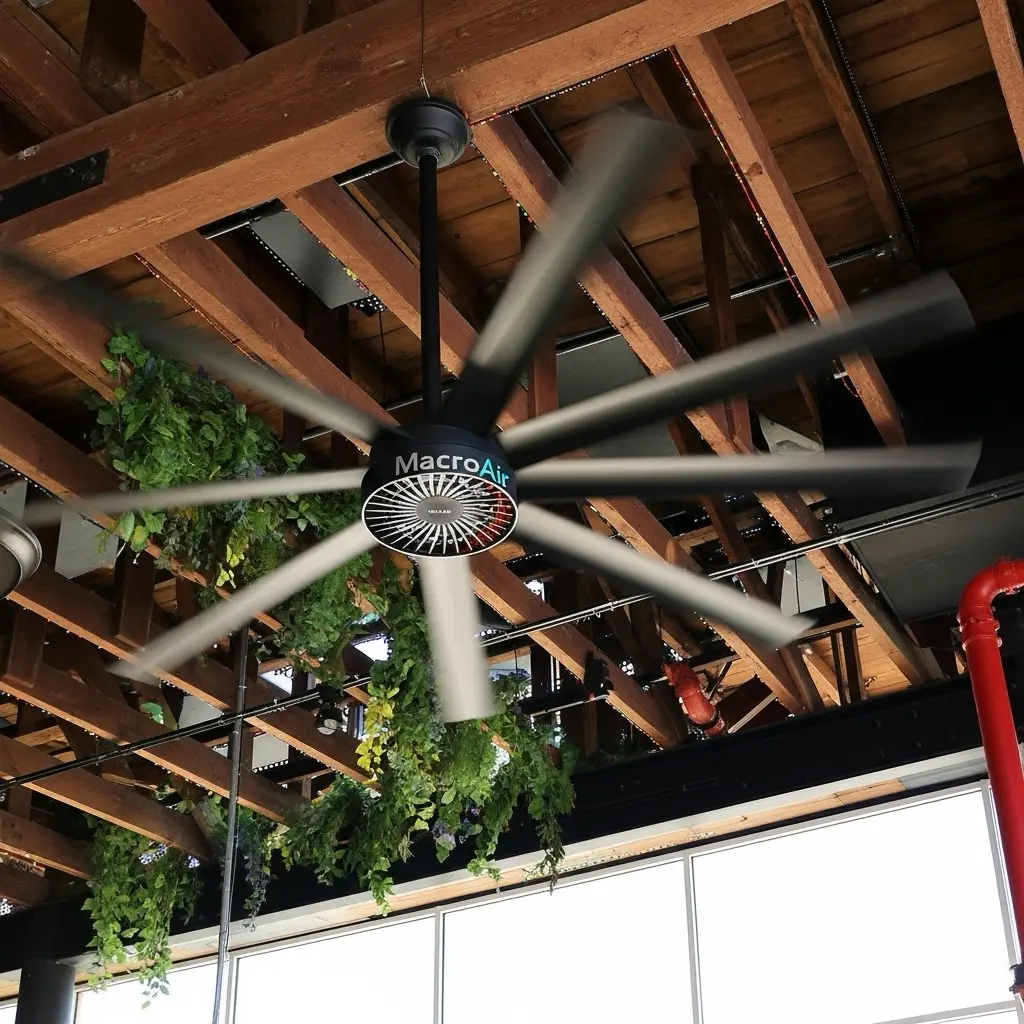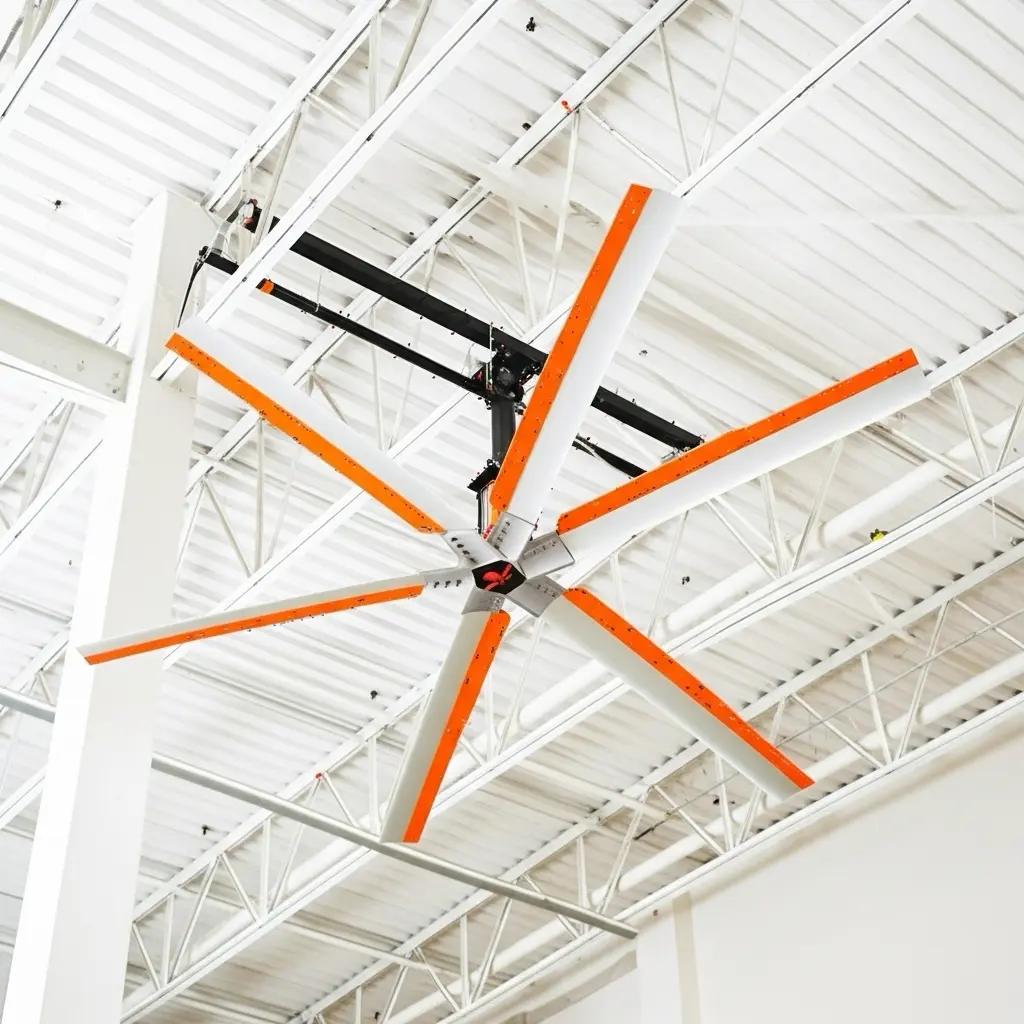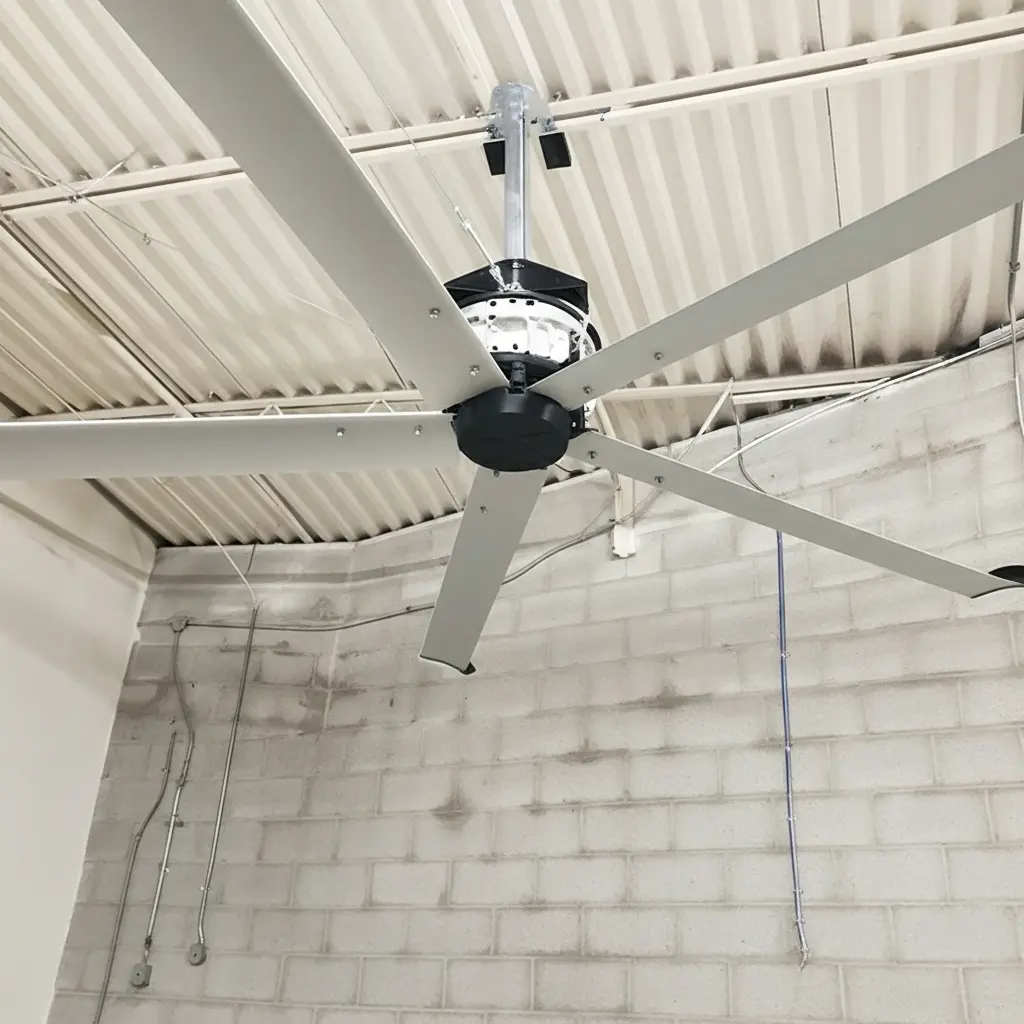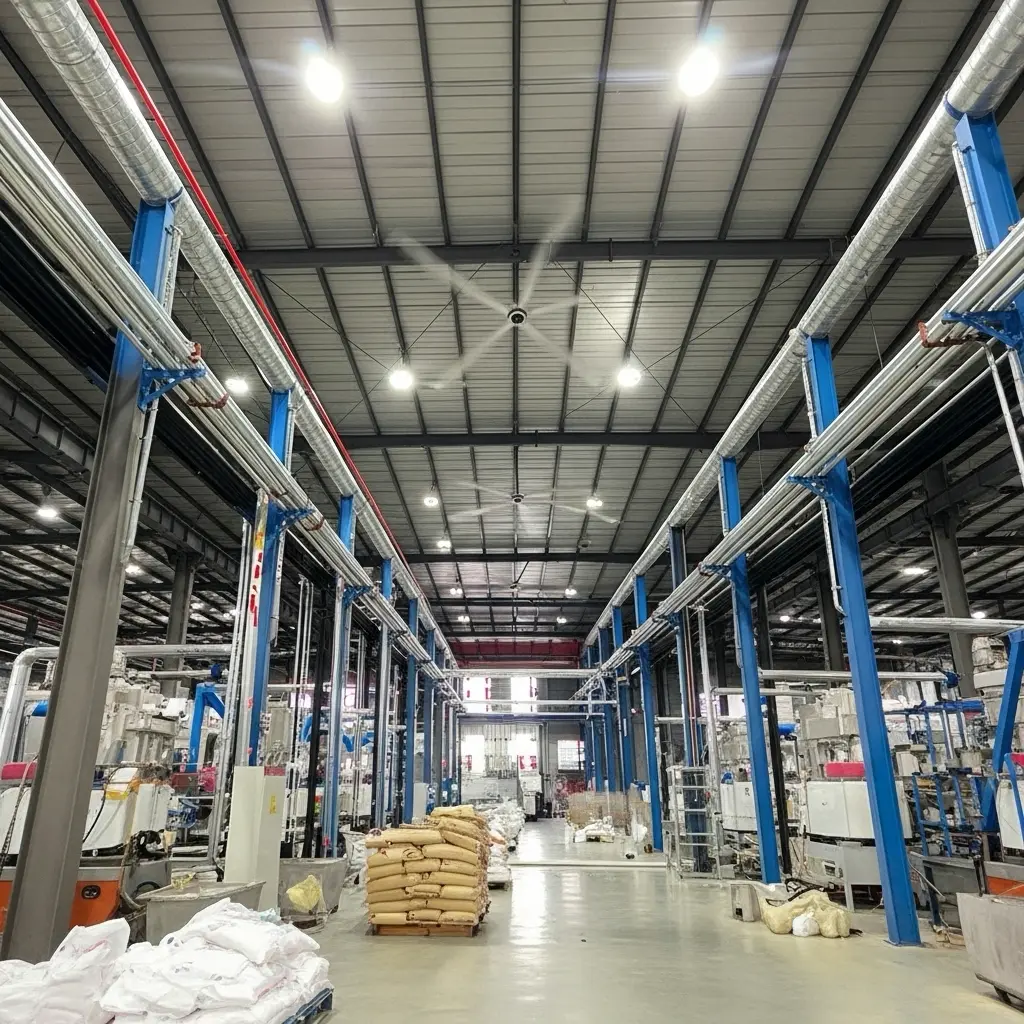Learn how low speed high volume ceiling fans improve air circulation, save energy, and enhance comfort in warehouses, gyms, and commercial facilities.
Table of Contents
Low speed high volume ceiling fans—also known as HVLS fans—represent the next evolution in energy-efficient climate control for large spaces. Whether it’s a warehouse, gym, barn, or manufacturing facility, these massive fans deliver smooth, consistent air movement that improves comfort and reduces energy costs. While they rotate slowly, their sheer size moves enormous volumes of air, covering up to 20,000 square feet per fan.

What Are Low Speed High Volume Ceiling Fans?
The term “low speed high volume” perfectly captures how these fans operate. Instead of spinning fast like traditional ceiling fans, they move slowly—often under 70 revolutions per minute—but with blades spanning 8 to 30 feet in diameter. This design pushes air downward in a steady column that spreads horizontally across the floor, cooling people and equipment by improving natural evaporation.
As Big Ass Fans explains, the secret lies in physics: large blades displace far more air with less effort. The resulting breeze is gentle but widespread, creating balanced airflow across vast areas. Compared to high-speed fans that waste energy creating turbulence, low speed high volume fans generate smooth, efficient circulation.
How They Work
These fans are designed to move air efficiently at low rotational speeds. As the large blades turn, they create a column of air that moves toward the floor. Upon reaching the ground, this airflow spreads outward in all directions, forming a “horizontal jet” that cools the surrounding area. This process is called destratification—it breaks down thermal layers, keeping temperatures consistent from ceiling to floor.
According to LED Lighting Supply, destratification can save up to 25% on heating costs in cold weather and up to 30% on cooling energy during summer months. The result is a more comfortable environment and a noticeable reduction in utility bills.
Benefits of Low Speed High Volume Fans
1. Energy Savings
Because these fans move large volumes of air efficiently, they reduce reliance on HVAC systems. In summer, they make occupants feel 6–10°F cooler, allowing thermostat settings to be raised without sacrificing comfort. In winter, reversing the fan direction recirculates warm air from the ceiling, reducing heating demand. Over a year, facilities can save thousands on energy costs.
2. Enhanced Air Quality
Good ventilation is essential in commercial and industrial environments. Low speed high volume ceiling fans disperse dust, fumes, and humidity, promoting healthier air. This benefit is particularly valuable in warehouses, gyms, and food-processing facilities where air stagnation leads to discomfort or health issues.

3. Improved Comfort and Productivity
According to Marut Air, one of the “surprising facts” about HVLS fans is how they improve comfort without creating drafty, noisy conditions. Workers, athletes, and animals all experience the cooling benefits of steady airflow, which translates to better morale and productivity. Even in large gyms or event centers, visitors enjoy fresher air and a more pleasant atmosphere.
4. Quiet Operation
Despite their immense size, low speed high volume fans are remarkably quiet. The smooth aerodynamic design of the blades, combined with direct-drive motors, minimizes mechanical noise. These systems are often quieter than normal conversation, making them suitable for auditoriums, schools, or retail spaces.
5. Long-Term Durability
Commercial-grade ceiling fans are engineered for longevity. High-quality aluminum blades resist corrosion, while sealed bearings protect against dust and moisture. Many come with warranties exceeding 10 years. As MacroAir notes, their “good, better, best” lineup ensures options for every budget—each built to industrial standards for 24/7 performance.
Applications Across Industries
- Warehouses & Distribution Centers: Combat heat buildup and ensure even temperatures.
- Manufacturing Plants: Disperse fumes and cool machinery areas.
- Agriculture & Barns: Provide consistent airflow to protect livestock health.
- Commercial Gyms: Keep air fresh during workouts, reducing humidity and odors.
- Airplane Hangars: Maintain even air distribution across vast open spaces.
Choosing the Right Low Speed High Volume Fan
As detailed in HVLS Fans Asia’s buying guide, the key is matching fan size and performance to your facility’s dimensions and ceiling height. Here’s a checklist for selecting the best model:
- Measure the space: Determine square footage and ceiling height to estimate the number and diameter of fans needed.
- Consider layout: Identify obstructions like lights, HVAC ducts, or beams that may affect airflow patterns.
- Check for energy efficiency: Choose fans with EC or PMSM motors for superior performance and lower power consumption.
- Review warranty and service: Reliable brands like Hunter, MacroAir, and Big Ass Fans offer long-term warranties and support networks.
- Look for control systems: Variable speed and smart controllers let you adjust airflow easily or automate operation.

Installation Insights
Installing low speed high volume ceiling fans requires careful attention to safety and spacing. According to Hunter Industrial, fans should be placed at least 10 feet above the floor, with 2–3 feet of clearance below the ceiling. For multiple fans, maintain spacing of 60–100 feet between units to prevent interference and ensure consistent airflow. Professional installation is strongly recommended to verify load-bearing capacity and compliance with local electrical codes.
For smaller or DIY-friendly spaces, you can take cues from Hampton Bay ceiling fan assembly principles: balance the blades, secure the mount, and double-check wiring. While low speed high volume fans are much larger, the fundamentals remain—stability, safety, and precision are key.
Maintenance and Longevity
Routine maintenance ensures long-term performance. Fortunately, these fans are low-maintenance. Simply clean the blades quarterly to prevent dust buildup, check bolts annually, and inspect safety cables. Direct-drive models require no belt or gearbox maintenance, minimizing downtime and cost.
ROI and Cost Considerations
The cost of a commercial HVLS fan varies by size and brand, ranging from $3,000 to $10,000 per unit. However, the energy savings quickly offset the investment. Many facilities recover their costs within two to three years through lower utility bills and improved working conditions. When factoring in HVAC savings and employee productivity, ROI improves even further.
Why Choose Low Speed High Volume Fans Over Traditional Ceiling Fans?
Traditional fans are designed for small areas and high-speed airflow, which creates turbulence and noise. Low speed high volume fans, by contrast, move air efficiently and quietly across huge areas. They don’t simply “stir” air—they circulate it evenly throughout the entire building, preventing temperature layering. The result: comfort, efficiency, and lower operational costs.
Canadian Climate Benefits
In Canada’s colder regions, such as Quebec or Alberta, temperature stratification can waste significant heating energy. Low speed high volume fans combat this by pushing warm air from the ceiling back down to occupied levels. During long winters, this process—called thermal destratification—can reduce heating bills by 20% or more. Pairing these fans with smart sensors or thermostats maximizes year-round efficiency.
FAQs About Low Speed High Volume Ceiling Fans
- Q: How big are these fans?
A: They typically range from 8 to 30 feet in diameter, depending on your space. - Q: Can I use them in air-conditioned buildings?
A: Absolutely. They complement HVAC systems by improving air mixing and reducing energy use. - Q: Do they require a lot of maintenance?
A: Very little—mostly periodic cleaning and inspections. - Q: Are they noisy?
A: No. With direct-drive motors, these fans operate almost silently. - Q: Do they work in winter?
A: Yes. Reversing direction redistributes heat evenly, lowering heating costs.
Conclusion
Low speed high volume ceiling fans are one of the most impactful upgrades for large buildings seeking comfort, energy efficiency, and air quality improvement. By replacing dozens of smaller fans with one or two strategically placed units, you gain superior airflow, quieter operation, and lower energy bills. Whether you manage a gym in Montreal, a warehouse in Toronto, or a dairy barn in Alberta, these fans offer reliable year-round performance and substantial cost savings.

